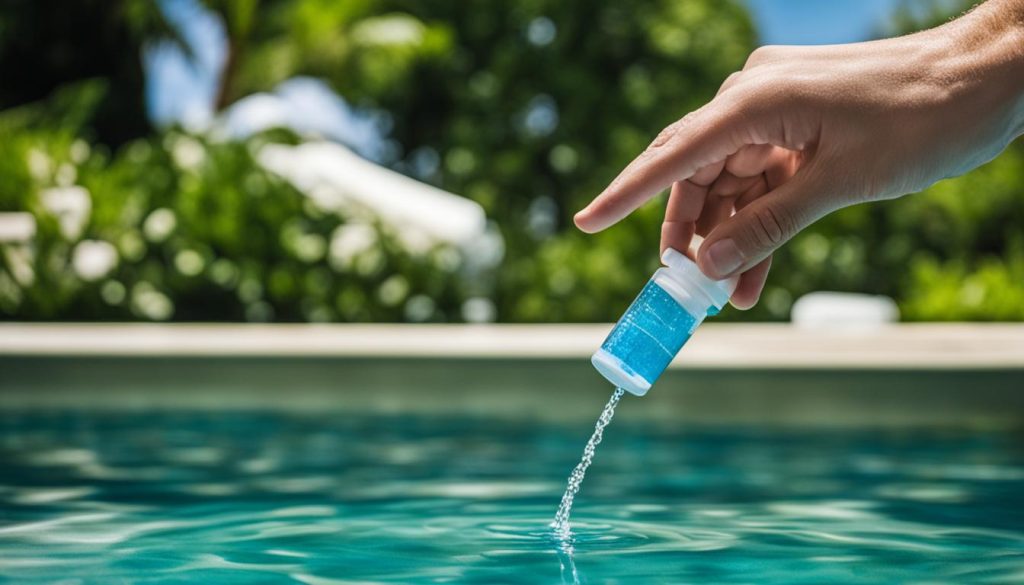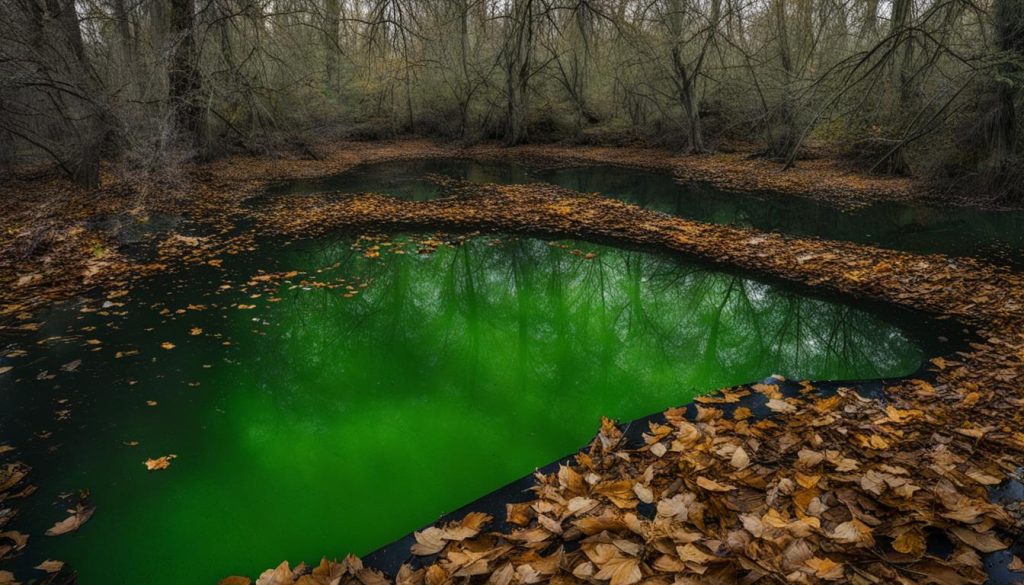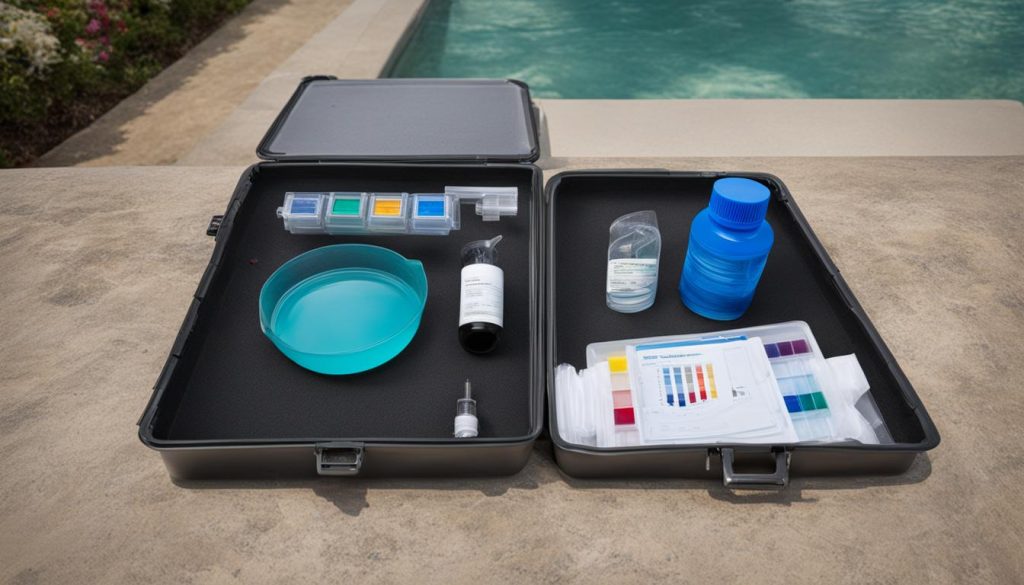Welcome to our comprehensive guide on pool water chemistry, where we will provide you with the knowledge needed to maintain a safe and enjoyable swimming experience. As Canadians, owning a pool is a significant investment, and understanding pool water chemistry is the key to protecting that investment. In this section, we will focus on the importance of balancing pH and chlorine levels in your pool. Maintaining the proper pH and chlorine levels are essential to prevent harmful bacteria growth, skin irritations, and overall water clarity.
Without proper maintenance, your pool water can become a breeding ground for bacteria and algae. Therefore, it is crucial to understand the impact of pH and chlorine levels on your pool. pH measures the acidity or alkalinity of your pool water. Ideal pH levels range from 7.2-7.8, and maintaining this range is vital for preventing skin irritations and corrosion of pool surfaces. Chlorine is the most common sanitizer used in swimming pools and helps to kill bacteria, viruses, and algae. Appropriate chlorine levels range from 1-3 parts per million (ppm). Ensuring the proper balance of these two elements is essential for maintaining a harmonious pool environment.
Our team is here to help you maintain the perfect balance of pH and chlorine levels in your pool water. In the following sections, we will dive deeper into each element’s importance and provide practical tips on how to test and adjust your pool’s pH and chlorine levels. We’ll also cover additional factors that can affect water chemistry, common pool water issues, and how to troubleshoot them effectively. By the end of this article, you’ll feel confident in maintaining your pool’s water chemistry, ensuring a safe and clean swimming experience for you and your family.
The Importance of pH Levels in Pool Water
At Pool Designers, we know that maintaining proper pH levels in your pool water is essential for a safe and enjoyable swimming experience. But why do pH levels matter?
Firstly, pH levels indicate the level of acidity or alkalinity in the water. If the pH level is too high, the water becomes more alkaline, which can cause skin and eye irritation, as well as make it harder for chlorine to properly sanitize the water. On the other hand, if the pH level is too low, the water becomes more acidic, which can also lead to skin and eye irritation, as well as damage pool equipment and surfaces.
Testing pH levels is easy with a simple pH test kit, which you can purchase at your local pool supply store. The ideal pH range for pool water is between 7.2 and 7.8. If the pH level is outside of this range, adjustments will need to be made by adding pH increaser or pH decreaser. We recommend testing the pH level at least twice a week, or more frequently during periods of heavy pool use or extreme weather.
Our team at Pool Designers can help you maintain proper pH levels and provide further guidance on testing and adjusting levels to ensure your pool remains in perfect balance.
Understanding Chlorine and Its Role in Pool Sanitization
In this section, we will delve into one of the most crucial elements of pool water chemistry: chlorine. Chlorine plays a significant role in pool sanitization by killing harmful bacteria, viruses, algae, and other contaminants present in the water. Without proper use of chlorine, your pool water can quickly become a breeding ground for various microorganisms, leading to serious health risks.
Chlorine’s sanitizing power works in two ways:
| Free chlorine | Combined chlorine |
|---|---|
| Chlorine that is still active and able to sanitize | Chlorine that has already sanitized the water and is no longer able to do so |
To maintain a safe swimming environment, it’s crucial to ensure that free chlorine levels remain between 2-4 parts per million (ppm). Combined chlorine levels should be kept below 0.2 ppm. If you notice an unpleasant odor or irritation in your eyes or skin, it may be an indication of high combined chlorine levels, and you should take immediate action to remedy the situation.
It’s essential to note that overuse of chlorine can also cause issues, such as skin and eye irritation, and even respiratory problems. Striking the right balance of chlorine requires accurate testing and careful monitoring. Different types of chlorine have their unique concentration levels and release rates, so it’s essential to choose the right type for your pool and follow the manufacturer’s instructions.
Additionally, chlorine levels can be influenced by factors such as temperature, sunlight, and the number of swimmers in the pool. Regular testing and adjusting of chlorine levels are crucial for maintaining optimal water quality and keeping swimmers safe.
Conclusion
Understanding the role of chlorine in pool water sanitization is essential for maintaining a safe and healthy swimming environment. By properly testing and monitoring chlorine levels, you can keep your pool free of harmful contaminants and provide an enjoyable swimming experience for all. In the next section, we will discuss the process of testing and balancing pH levels for optimal water chemistry.
Testing and Balancing pH Levels
Accurately testing and balancing pH levels is crucial for maintaining the clarity and health of your pool water. pH levels that are too high or too low can cause skin irritation, cloudy water, and reduce the effectiveness of chlorine in sanitizing the water.
The ideal pH range for pool water is between 7.2 and 7.8. Testing pH levels can be done using test strips or a liquid testing kit. Test strips are easier to use, but liquid kits are more accurate.
If the pH level is too low, add a pH increaser such as sodium carbonate to raise the pH level. If the pH level is too high, add a pH decreaser like sodium bisulfate to lower the pH level. Always follow the manufacturer’s instructions when adding chemicals to your pool.
In addition to pH levels, Total Alkalinity (TA) and Calcium Hardness (CH) also play a role in maintaining proper water chemistry. High TA levels can lead to cloudy water, while low TA levels can cause pH fluctuations. CH levels that are too low can cause damage to pool surfaces, while high CH levels can lead to scaling and cloudy water.
| Chemical | Ideal Range | How to Adjust |
|---|---|---|
| Total Alkalinity | 80-120 ppm | Add alkalinity increaser to raise levels, or muriatic acid to lower levels |
| Calcium Hardness | 200-400 ppm | Add calcium hardness increaser to raise levels, or drain and refill with fresh water to lower levels |
It’s important to test and balance all of these factors regularly to maintain optimal water chemistry. Our team at Pool Designers can provide additional guidance and support for all your pool maintenance needs.
Maintaining Proper Chlorine Levels
Ensuring proper chlorine levels is vital to prevent the growth of bacteria and algae, which can cause skin irritation and other health issues. It’s essential to test your pool water regularly to determine the appropriate chlorine levels, which should be between 1-3 ppm (parts per million).
| Chlorine Forms | Pros | Cons |
|---|---|---|
| Chlorine tablets | Easy to use, Slow-dissolving | May cause over-stabilization, which can hamper chlorine effectiveness |
| Liquid Chlorine | Fast-acting, Effective for larger pools | Requires handling, may cause liner staining |
| Granular Chlorine | Quick-dissolving, can be used as a shock treatment | May cause over-stabilization, which can hamper chlorine effectiveness |
Note: Be sure to wear proper protective equipment when handling chlorine products.
In addition to the above, shock treatments can help boost chlorine levels and remove any contaminants that may have accumulated in the water. It’s recommended to shock your pool at least once a week, especially after heavy usage or rain.

It’s important to monitor chlorine levels carefully, as an over or under-chlorinated pool can create a range of problems. Too much chlorine can cause skin irritation, while too little can allow bacteria and algae to thrive.
By regularly testing and maintaining proper chlorine levels, you can ensure a clean and safe swimming environment for you and your family.
Additional Factors Affecting Water Chemistry
While pH and chlorine levels are crucial elements in maintaining pool water chemistry, several other factors also play a significant role. It’s essential to understand and address these factors to ensure optimal water quality and clarity. Let’s take a closer look:
Alkalinity
Alkalinity refers to the level of alkaline substances in pool water, such as bicarbonates and carbonates. Maintaining proper alkalinity levels can help stabilize pH levels and prevent rapid fluctuations. Low alkalinity can lead to corrosive water, while high levels can cause scaling and cloudy water.
Calcium Hardness
Calcium hardness refers to the concentration of calcium and magnesium in pool water. Proper calcium hardness levels can prevent corrosion and scaling on pool surfaces and equipment. Low levels can cause water to be aggressive, while high levels can create cloudy water and scaling.
Total Dissolved Solids (TDS)
TDS refers to the total amount of dissolved material in pool water. It includes minerals, chemicals, and other substances that can accumulate over time. High levels of TDS can indicate a need for water replacement, as it can affect water quality and clarity.

It’s crucial to test alkalinity, calcium hardness, and TDS regularly and make adjustments as needed. A comprehensive water analysis can provide detailed insights into these factors and guide you in maintaining optimal water chemistry.
Troubleshooting Common Pool Water Issues
Even when you’re careful to maintain proper pool water chemistry, problems can arise. In this section, we’ll address some common pool water issues and provide troubleshooting tips to help you deal with them. By following these guidelines, you can ensure that your pool remains clean, safe, and enjoyable for everyone.
Cloudy Water
Cloudy water is a common issue in pool maintenance. Often, it’s caused by poor filtration or insufficient water circulation. To troubleshoot this issue, try the following:
| Possible Causes | Solutions |
|---|---|
| The pool filter needs cleaning or replacement. | Clean or replace the filter. Backwash the sand filter or clean the cartridge filter according to the manufacturer’s instructions. |
| The pool water needs more chlorine. | Test the chlorine levels and add more if necessary. Shock the pool with chlorine if the levels are very low. |
| The pool water has high pH or alkalinity levels. | Test the pH and alkalinity levels and adjust them as necessary. Use a pH decreaser or alkalinity reducer according to the manufacturer’s instructions. |
Algae Growth
Algae growth in your pool is a sign that the water chemistry is imbalanced. To address this issue, try the following:
| Possible Causes | Solutions |
|---|---|
| The pool water has low chlorine levels. | Test the chlorine levels and add more if necessary. Shock the pool with chlorine to kill the algae. |
| The pool water has high pH or alkalinity levels. | Test the pH and alkalinity levels and adjust them as necessary. Use a pH decreaser or alkalinity reducer according to the manufacturer’s instructions. |
| The pool filter is not working correctly. | Check and clean the filter according to the manufacturer’s instructions. Backwash the sand filter or clean the cartridge filter. |
Skin Irritations
Swimmers may experience skin irritations if the pool water is not properly balanced. To address this issue, try the following:
| Possible Causes | Solutions |
|---|---|
| The pool water has high pH or alkalinity levels. | Test the pH and alkalinity levels and adjust them as necessary. Use a pH decreaser or alkalinity reducer according to the manufacturer’s instructions. |
| The pool water has high chlorine levels. | Test the chlorine levels and adjust them as necessary. If the levels are too high, wait for them to lower before using the pool again. |
| The pool water has high levels of total dissolved solids (TDS). | Drain and refill the pool with fresh water. |
By troubleshooting these common pool water issues, you can ensure that your pool stays clean and healthy for everyone who uses it.

Conclusion: Enjoy a Safe and Clean Swimming Experience
At Pool Designers, we believe that balancing pool water chemistry is paramount for ensuring a safe and enjoyable swimming experience. By following the guidelines outlined in this article, you can maintain proper pH and chlorine levels, as well as address other factors affecting water quality.
Remember to regularly test and adjust the chemistry of your pool water, as imbalanced levels can lead to issues such as cloudy water, algae growth, and skin irritations. However, with proper care and maintenance, you can create a visually appealing, healthy, and inviting pool environment.
We hope this comprehensive guide has been helpful in understanding the importance of pool water chemistry. For further assistance or to schedule a pool maintenance appointment, do not hesitate to contact us at (647) 812-7735. Let’s collaborate to craft a secure and pristine swimming experience for you and your family, whether it’s a fiberglass, vinyl, or concrete pool.
FAQ
What is the importance of balancing pH and chlorine levels in pool water?
Balancing pH and chlorine levels in pool water is crucial for maintaining a safe and enjoyable swimming experience. Proper pH levels ensure water clarity and prevent skin and eye irritation, while adequate chlorine levels help sanitize the water by killing bacteria, algae, and other contaminants.
Why are pH levels important in pool water?
Maintaining proper pH levels in your pool water is essential because it affects the effectiveness of chlorine and other sanitizing agents. Low pH levels can cause corrosion and irritation, while high pH levels can lead to cloudy water and reduced chlorine efficacy. Regular testing and adjustment of pH levels help ensure optimal water quality.
What is the role of chlorine in pool sanitization?
Chlorine plays a vital role in pool sanitization by effectively killing bacteria, algae, and other contaminants in the water. It helps maintain water clarity and prevents the growth of harmful organisms. Regular monitoring and maintenance of chlorine levels are necessary to ensure proper sanitization.
How can I test and balance pH levels in my pool water?
Testing pH levels in your pool water can be done using reliable methods such as test strips or liquid test kits. Once you determine the pH level, you can adjust it by adding pH increaser (sodium carbonate) to raise the pH or pH reducer (sodium bisulfate) to lower it. Regular testing and adjustment of pH levels will help maintain water balance.
How do I maintain proper chlorine levels in my pool?
To maintain proper chlorine levels, it is important to regularly test the water and adjust as necessary. Chlorine can be added in the form of tablets, granules, or liquid solutions. Additionally, shock treatments can help boost chlorine levels and eliminate contaminants. Consistent testing and maintenance are essential for effective pool sanitization.
What other factors can affect water chemistry besides pH and chlorine levels?
Besides pH and chlorine levels, other factors such as alkalinity, calcium hardness, and total dissolved solids (TDS) can impact water chemistry. Alkalinity helps stabilize pH levels, while calcium hardness prevents corrosion. High TDS can lead to cloudy water. Regular testing and appropriate adjustments are necessary for optimal water chemistry.
How can I troubleshoot common pool water issues?
Common pool water issues like cloudy water, algae growth, and skin irritations can be resolved by understanding the underlying causes. Testing water chemistry, adjusting pH and chlorine levels, and ensuring proper filtration and circulation are essential troubleshooting steps. Regular maintenance and addressing issues promptly will help maintain a clean and inviting pool.

